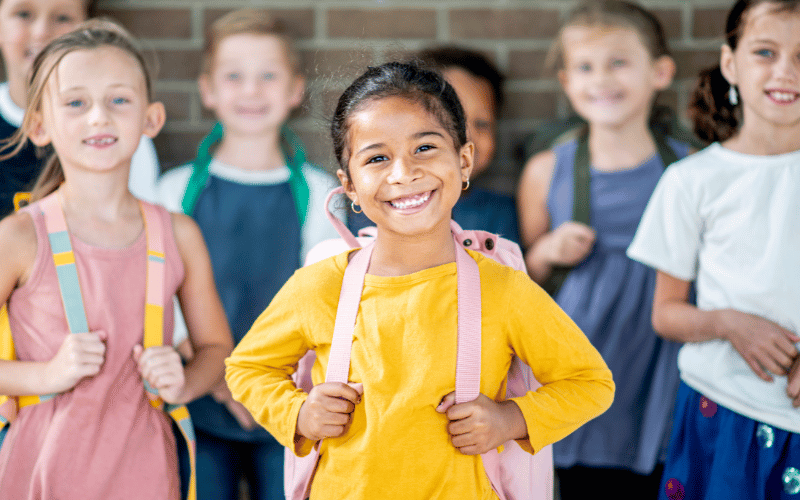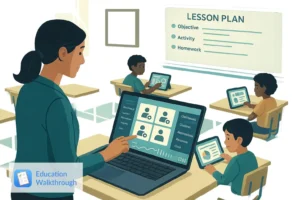Student centered learning puts students at the forefront of their education, allowing them to shape their learning paths. This approach improves engagement, personalization, and outcomes. This article will detail what student centered learning is, its fundamental principles, and effective strategies to apply in the classroom.
Key Takeaways
- Student-centered learning shifts the focus from the teacher to the student, emphasizing student voice, choice, and personalized learning experiences.
- Key principles of student-centered learning include differentiation, collaboration, and engagement through inquiry-based and project-based learning strategies.
- The transformation in the teacher’s role to a facilitator fosters a supportive learning environment, enhancing student motivation, critical thinking skills, and overall academic outcomes.

Understanding the essence of student-centered learning is the first step in revolutionizing teaching practices. Unlike traditional classrooms where the teacher is the primary source of knowledge, student-centered learning places students at the core of the educational experience.
Incorporating diverse teaching strategies and adapting to individual learning styles structures classroom activities around students’ interests and needs. Imagine a classroom where students work on their own questions or projects, rather than simply listening to lectures—this is the hallmark of a student-centered classroom, fostering a more engaging and personalized learning environment.
Defining Student Centered Learning
Student-centered learning is a pedagogical approach that shifts the focus from the teacher to the student. At its core, student-centered learning considers student voices and choices, allowing them to drive their learning process. This method not only makes the educational experience more meaningful but also engages students by aligning learning activities with their interests. In a student-centered classroom, students are co-creators of their education, involved in decisions about what, when, and how they learn. This student centered learning approach is characterized by active learning, small group discussions, and student-led initiatives, creating a learning environment that adapts to the needs of individual students.
Student-centered learning is grounded in constructivist theory, which encourages students learn to apply skills to real-world issues, fostering authentic learning experiences. For instance, students might work on increasing recycling in their school, reflecting on the changes in habits and skills they have learned.
Engaging students at the center of their educational experience supports academic growth and encourages exploration through discovery learning.
Historical Context
The roots of student-centered learning can be traced back to constructivist theory, which emphasizes the active construction of knowledge by learners. Over time, this theoretical approach has evolved, shifting the focus from traditional, teacher-centered methods to practices that prioritize student agency and engagement.
This evolution reflects a broader trend in education towards more personalized and meaningful learning experiences, adapting constructivist principles to modern educational settings.
Key Principles of Student Centered Learning
Embracing student-centered learning involves understanding key principles that guide its structure and implementation in modern classrooms. These principles include emphasizing student voice and choice, differentiating and personalizing instruction, and promoting collaboration.
Each principle plays a crucial role in creating a learning environment that engages students and supports their individual learning journeys.
Emphasizing Student Voice and Choice
In a student-centered classroom, student voice and choice are paramount. This means students have a say in how they learn, what resources they use, and how they demonstrate their competence. Engaging student voices in instructional planning through discussions or interest surveys ensures that the educational content is relevant and engaging. This approach not only enhances student interest but also encourages ownership and responsibility for their learning, leading to a more meaningful educational experience.
Elementary settings, in particular, benefit from student-centered learning as it allows young learners to choose topics and formats for their projects, increasing their engagement and motivation. Co-constructing learning goals and having a say in their education help students develop a deeper connection to their learning journey, fostering a sense of empowerment and autonomy.
Differentiation and Personalization
Differentiation and personalization are cornerstones of the student-centered approach, catering to the unique needs and learning styles of individual students. In student-centered classrooms, teachers collaborate with students to create tailored education plans that address diverse learning preferences and abilities. This requires educators to be flexible and adaptive, using various instructional methods to meet the needs of all learners.
Understanding each student’s circumstances and learning style is crucial for effective student-centered instruction. Personalizing the learning experience helps create a supportive and engaging environment that fosters student growth and achievement.
This often results in a less formal classroom setting, where students feel comfortable exploring and expressing their ideas. Establishing clear expectations can help balance the freedom of personalization with the necessary structure to guide students’ learning paths.
Promoting Collaboration
Collaboration is a vital aspect of student-centered learning, encouraging students to work together in pairs or small groups to solve problems and complete projects. In these collaborative environments, students manage their own groups, select their tasks, and navigate the challenges together, enhancing their communication and teamwork skills. This collaborative approach not only supports academic learning but also helps students develop social and emotional skills essential for their future.
Interdisciplinary projects are a common feature in student-centered classrooms, where students from different disciplines come together to tackle complex problems. Colleges that have adopted student-centered approaches often see enhanced collaboration among students, leading to more effective problem-solving skills and a richer learning experience.
To effectively implement student-centered learning, educators must employ various instructional strategies that engage students and foster a dynamic learning environment. These strategies include inquiry-based learning, project-based learning, and flexible seating and classroom design.
Each of these methods plays a crucial role in supporting students’ active participation and personalizing their educational experiences.
Inquiry-Based Learning
Inquiry-based learning is a powerful instructional strategy that encourages students to ask questions, explore topics of interest, and develop a deeper understanding of the subject matter. This approach enhances critical thinking skills by prompting students to investigate real-world issues, fostering a sense of curiosity and engagement. In a student-centered classroom, inquiry-based learning allows students to take control of their learning journey, making the educational experience more meaningful and relevant to their lives.
Through inquiry-based learning, students engage in hands-on activities and collaborative projects that require them to apply their knowledge in practical ways. This active learning process not only supports the development of critical thinking and problem-solving skills but also helps students build confidence in their abilities to explore and understand complex concepts.
Encouraging students to be curious and pursue their own learning paths through inquiry-based learning creates a dynamic and engaging classroom environment.
Project-Based Learning
Project-based learning (PBL) is another effective strategy that involves students investigating and solving real-world problems. This method focuses on teaching students to identify and explore problems, learn relevant skills, and reflect on their learning experiences. In a student-centered learning environment, PBL not only engages students but also connects their classroom knowledge to real-world contexts, making learning more relevant and impactful.
For example, students might design dream houses while learning about architecture, vocabulary, and math, or work on community projects that address local issues. Through these projects, students develop critical thinking, problem-solving, and teamwork skills, as well as a sense of responsibility and accomplishment.
Reflecting on the skills learned and changes made in their communities helps students gain a deeper understanding of the importance and application of their education.
Flexible Seating and Classroom Design
Flexible seating and classroom design are essential components of a student-centered classroom, promoting collaboration and active engagement. Arranging the classroom with various seating options and collaborative spaces creates a supportive physical environment that encourages students to work together and communicate effectively. This approach not only enhances the learning experience but also contributes to a positive and inclusive classroom atmosphere.
A well-designed physical space can significantly influence student engagement and learning outcomes. By incorporating flexible seating arrangements, teachers can create a classroom environment that adapts to the needs of individual students and supports a variety of learning activities. This flexibility allows students to choose the seating and working arrangements that best suit their learning styles, fostering a sense of ownership and autonomy in their educational journey.
The Role of Teachers in Student Centered Classrooms

In student-centered classrooms, the role of teachers transforms significantly from being the primary authority figure to becoming facilitators and guides who support and empower students in their learning journey. This shift requires teachers to adopt new skills and approaches that promote active student participation and collaboration.
Acting as mentors and resource connectors, teacher teachers help students take ownership of their learning and develop essential skills for success.
Facilitating Learning
Facilitating learning in a student-centered classroom involves creating an environment where students can actively engage with the material and take responsibility for their own learning. Teachers support students by modeling learning behaviors, providing constructive feedback, and encouraging independent thinking. This approach empowers students to set their own goals and pursue their interests, fostering a sense of autonomy and self-direction.
In a flexible classroom, teachers must monitor student progress and demonstrate necessary skills to guide students effectively. Understanding each student’s learning process and adapting instruction accordingly creates a supportive environment that encourages critical thinking and problem-solving.
Additionally, allowing students to participate in their own assessment and present their work helps build confidence and communication skills. Teachers also connect students with academic and community resources to support their learning and provide guidance while allowing students the autonomy to explore their interests.
Building Relationships
Building strong relationships between teachers and students is crucial for creating a supportive and engaging learning environment. Trust and open communication are essential for fostering a classroom atmosphere where students feel safe to take risks and express their ideas. Positive relationships enhance student motivation and engagement, leading to improved academic outcomes and a more meaningful educational experience.
In a student-centered classroom, teachers focus on developing a deep understanding of each student’s interests, strengths, and challenges. Building strong connections with students allows teachers to provide personalized support and encouragement, helping students navigate their learning journey. This approach not only supports academic growth but also fosters a sense of belonging and community within the classroom.
Benefits of Student Centered Learning
Student-centered learning offers numerous benefits for both students and educators, including increased engagement and motivation, the development of critical thinking skills, and improved academic outcomes. Shifting the focus from teacher-led instruction to student-driven learning creates a more dynamic and personalized educational experience that supports the growth and development of all students.
Increased Engagement and Motivation
One of the most significant benefits of student-centered learning is the increase in student engagement and motivation. When students have a voice in classroom decisions and their interests are considered, they are more likely to seek a deeper understanding of their learning goals. Strong relationships with trusted adults in the classroom also provide the confidence and motivation students need to flourish. Many students report feeling a greater sense of purpose and connection to their education in student-centered environments, which leads to enhanced engagement and achievement.
Research shows a correlation between student-centered instruction and improved engagement and achievement, particularly in subjects like mathematics. Schools promoting learner dispositions such as curiosity and ownership observe enhanced engagement and positive learning outcomes. Colleges adopting student-centered learning initiatives report increased student satisfaction and improved perceived quality of education, further demonstrating the benefits of this approach.
Development of Critical Thinking Skills
Student-centered learning environments are particularly effective in developing critical thinking skills. By encouraging students to explore concepts rather than simply providing answers, teachers help students become more independent and analytical thinkers. Hands-on and group learning experiences, which are characteristic of student-centered classrooms, further enhance critical thinking by requiring students to apply their knowledge in practical and collaborative contexts.
Elementary schools that have implemented student-centered practices report significant improvements in students’ critical thinking and problem-solving abilities. These skills are not only crucial for academic success but also for students’ future careers and personal lives. By fostering a mindset of inquiry and analysis, student-centered learning prepares students to navigate complex challenges and make informed decisions.
Improved Academic Outcomes
The impact of student-centered learning on academic outcomes is profound. Research indicates that students in student-centered environments often achieve higher test scores and show greater understanding of subject material. By engaging students more effectively in the learning process, this approach enhances both academic performance and personal growth.
In addition to academic success, student-centered learning fosters essential skills such as self-regulation and intrinsic motivation. These skills contribute to students’ overall development, helping them become more self-directed and resilient learners.
The holistic improvement in both academic outcomes and personal growth underscores the value of implementing student-centered learning strategies in modern classrooms.
Addressing Challenges in Student Centered Learning
While the benefits of student-centered learning are clear, transitioning to this approach presents several challenges. These include significant shifts in roles, room design, and communication styles, as well as initial resistance from both teachers and students.
Overcoming these challenges requires thoughtful planning and gradual implementation of student-centered techniques.
Transitioning from Traditional to Student Centered Approaches
Transitioning to a student-centered classroom requires both teachers and students to adopt new skills and collaborative methods. Accommodating diverse student needs in student-centered learning may prove challenging at first, as it requires a shift from traditional teacher-centered approaches.
One effective strategy is to integrate student-centered learning into traditional classrooms by allocating specific portions of the day for this approach, allowing for a structured way to introduce flexibility in education. Teachers and students must learn new skills and ways of working together, which can be a gradual process.
However, the implementation of student-centered learning has shown to close achievement gaps for economically disadvantaged students, demonstrating its potential to create more equitable educational outcomes.
Balancing Structure and Flexibility
Balancing structure and flexibility is crucial in a student-centered learning environment. Formative assessments play a significant role in providing ongoing feedback and adjusting teaching strategies to meet students’ needs. This approach allows educators to create a responsive learning environment that supports diverse learners while maintaining necessary structure.
Students with diverse needs often require tier 2 or tier 3 interventions to ensure they receive the necessary support within a flexible learning framework. By integrating formative assessments and providing tailored support, educators can offer both autonomy and guidance, creating a balanced and effective learning environment.
Creating a Student Centered Learning Environment

Creating a student-centered learning environment involves implementing key elements such as:
- Student voice
- Choice
- Competency-based progression
- Continuous assessment of student needs
These elements help establish a supportive and engaging learning environment where students feel motivated and empowered to take ownership of their education.
Incorporating Technology
Incorporating technology into student-centered learning enhances engagement by allowing for personalized learning experiences. Digital tools provide real-time feedback, essential for a student-centered approach, and support personalized instruction that caters to diverse student needs.
Many middle and secondary schools have successfully integrated technology to personalize learning experiences, making education more relevant and engaging for students. Leveraging technology allows educators to create a dynamic learning environment that supports students’ individual learning paths and fosters greater engagement.
Encouraging Self-Assessment and Reflection
Self-assessment and reflection are critical components of student-centered learning, fostering a sense of autonomy and responsibility in students. By encouraging students to assess their own work and reflect on their learning progress, educators help them identify strengths and areas for growth, guiding their personal learning goals.
At Lewis and Clark Elementary, for example, students actively participate in assessing their learning progress through self-directed questions, which helps them take ownership of their educational journey. This reflective practice not only enhances student learning but also builds critical thinking and self-regulation skills, essential for lifelong learning.
In summary, student-centered learning transforms traditional educational practices by placing students at the core of their learning experience. This approach enhances engagement, motivation, critical thinking skills, and academic outcomes, creating a more dynamic and personalized educational journey. By understanding and implementing the key principles and strategies of student-centered learning, educators can create supportive and engaging learning environments that foster the growth and development of all students. Embracing this approach not only benefits students academically but also prepares them for future success in an ever-changing world.
Common Questions on Student Centered Learning
What is an example of student-centred learning?
An example of student-centred learning is project-based learning, where students engage in real-world problems and work collaboratively to find solutions. This approach allows students to take charge of their own learning journey, fostering critical thinking and problem-solving skills.
What does student-centered learning look like in the classroom?
In the classroom, student-centered learning involves students actively participating in discussions, working in small groups, and engaging in hands-on activities. Teachers act as facilitators, guiding students as they explore topics of interest and pursue their own learning paths.
What do you mean by learner-centered learning?
Learner-centered learning is an approach that places students at the heart of the educational process, emphasizing their interests, needs, and active involvement. This method encourages students to take ownership of their education, making learning more meaningful and personalized.
What are the four main characteristics of a student-centered learning model?
The four main characteristics of a student-centered learning model include active participation, personalized learning experiences, collaboration among students, and the development of critical thinking skills. These elements create a dynamic and engaging learning environment that supports student growth and achievement.




